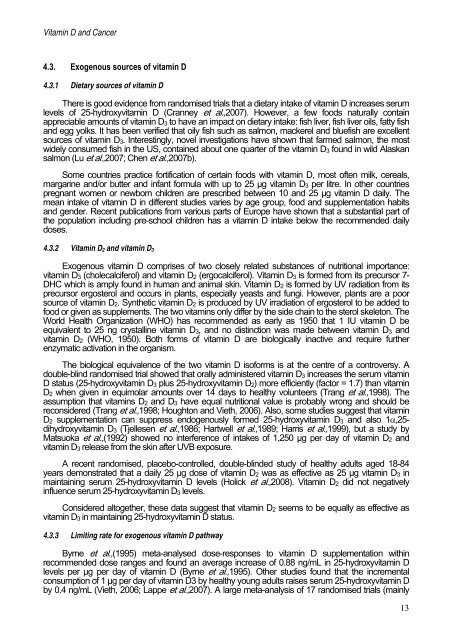You also want an ePaper? Increase the reach of your titles
YUMPU automatically turns print PDFs into web optimized ePapers that Google loves.
Vitamin D and Cancer<br />
4.3. Exogenous sources of vitamin D<br />
4.3.1 Dietary sources of vitamin D<br />
There is good evidence from randomised trials that a dietary intake of vitamin D increases serum<br />
levels of 25-hydroxyvitamin D (Cranney et al.,2007). However, a few foods naturally contain<br />
appreciable amounts of vitamin D3 to have an impact on dietary intake: fish liver, fish liver oils, fatty fish<br />
and egg yolks. It has been verified that oily fish such as salmon, mackerel and bluefish are excellent<br />
sources of vitamin D3. Interestingly, novel investigations have shown that farmed salmon, the most<br />
widely consumed fish in the US, contained about one quarter of the vitamin D3 found in wild Alaskan<br />
salmon (Lu et al.,2007; Chen et al.,2007b).<br />
Some countries practice fortification of certain foods with vitamin D, most often milk, cereals,<br />
margarine and/or butter and infant formula with up to 25 µg vitamin D3 per litre. In other countries<br />
pregnant women or newborn children are prescribed between 10 and 25 µg vitamin D daily. The<br />
mean intake of vitamin D in different studies varies by age group, food and supplementation habits<br />
and gender. Recent publications from various parts of Europe have shown that a substantial part of<br />
the population including pre-school children has a vitamin D intake below the recommended daily<br />
doses.<br />
4.3.2 Vitamin D2 and vitamin D3<br />
Exogenous vitamin D comprises of two closely related substances of nutritional importance:<br />
vitamin D3 (cholecalciferol) and vitamin D2 (ergocalciferol). Vitamin D3 is formed from its precursor 7-<br />
DHC which is amply found in human and animal skin. Vitamin D2 is formed by UV radiation from its<br />
precursor ergosterol and occurs in plants, especially yeasts and fungi. However, plants are a poor<br />
source of vitamin D2. Synthetic vitamin D2 is produced by UV irradiation of ergosterol to be added to<br />
food or given as supplements. The two vitamins only differ by the side chain to the sterol skeleton. The<br />
World Health Organization (WHO) has recommended as early as 1950 that 1 IU vitamin D be<br />
equivalent to 25 ng crystalline vitamin D3, and no distinction was made between vitamin D3 and<br />
vitamin D2 (WHO, 1950). Both forms of vitamin D are biologically inactive and require further<br />
enzymatic activation in the organism.<br />
The biological equivalence of the two vitamin D isoforms is at the centre of a controversy. A<br />
double-blind randomised trial showed that orally administered vitamin D3 increases the serum vitamin<br />
D status (25-hydroxyvitamin D3 plus 25-hydroxyvitamin D2) more efficiently (factor = 1.7) than vitamin<br />
D2 when given in equimolar amounts over 14 days to healthy volunteers (Trang et al.,1998). The<br />
assumption that vitamins D2 and D3 have equal nutritional value is probably wrong and should be<br />
reconsidered (Trang et al.,1998; Houghton and Vieth, 2006). Also, some studies suggest that vitamin<br />
D2 supplementation can suppress endogenously formed 25-hydroxyvitamin D3 and also 1α,25dihydroxyvitamin<br />
D3 (Tjellesen et al.,1986; Hartwell et al.,1989; Harris et al.,1999), but a study by<br />
Matsuoka et al.,(1992) showed no interference of intakes of 1,250 µg per day of vitamin D2 and<br />
vitamin D3 release from the skin after UVB exposure.<br />
A recent randomised, placebo-controlled, double-blinded study of healthy adults aged 18-84<br />
years demonstrated that a daily 25 µg dose of vitamin D2 was as effective as 25 µg vitamin D3 in<br />
maintaining serum 25-hydroxyvitamin D levels (Holick et al.,2008). Vitamin D2 did not negatively<br />
influence serum 25-hydroxyvitamin D3 levels.<br />
Considered altogether, these data suggest that vitamin D2 seems to be equally as effective as<br />
vitamin D3 in maintaining 25-hydroxyvitamin D status.<br />
4.3.3 Limiting rate for exogenous vitamin D pathway<br />
Byrne et al.,(1995) meta-analysed dose-responses to vitamin D supplementation within<br />
recommended dose ranges and found an average increase of 0.88 ng/mL in 25-hydroxyvitamin D<br />
levels per µg per day of vitamin D (Byrne et al.,1995). Other studies found that the incremental<br />
consumption of 1 µg per day of vitamin D3 by healthy young adults raises serum 25-hydroxyvitamin D<br />
by 0.4 ng/mL (Vieth, 2006; Lappe et al.,2007). A large meta-analysis of 17 randomised trials (mainly<br />
13

















